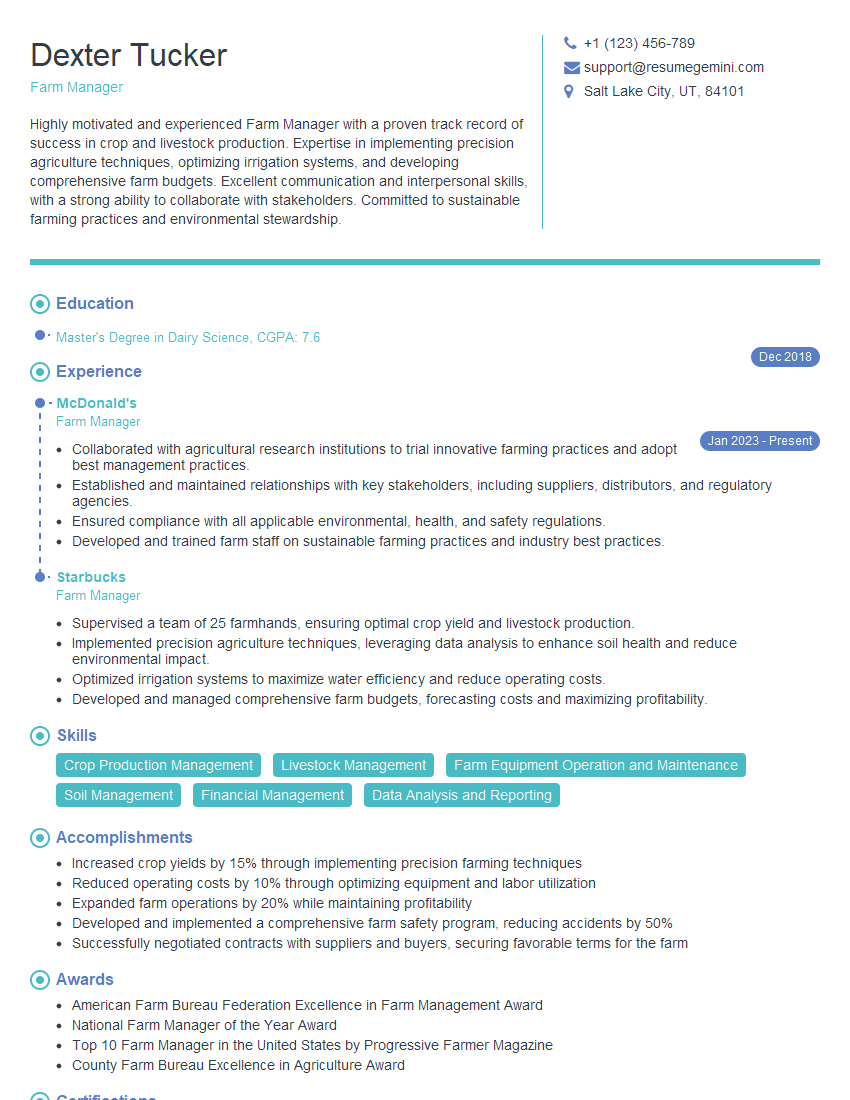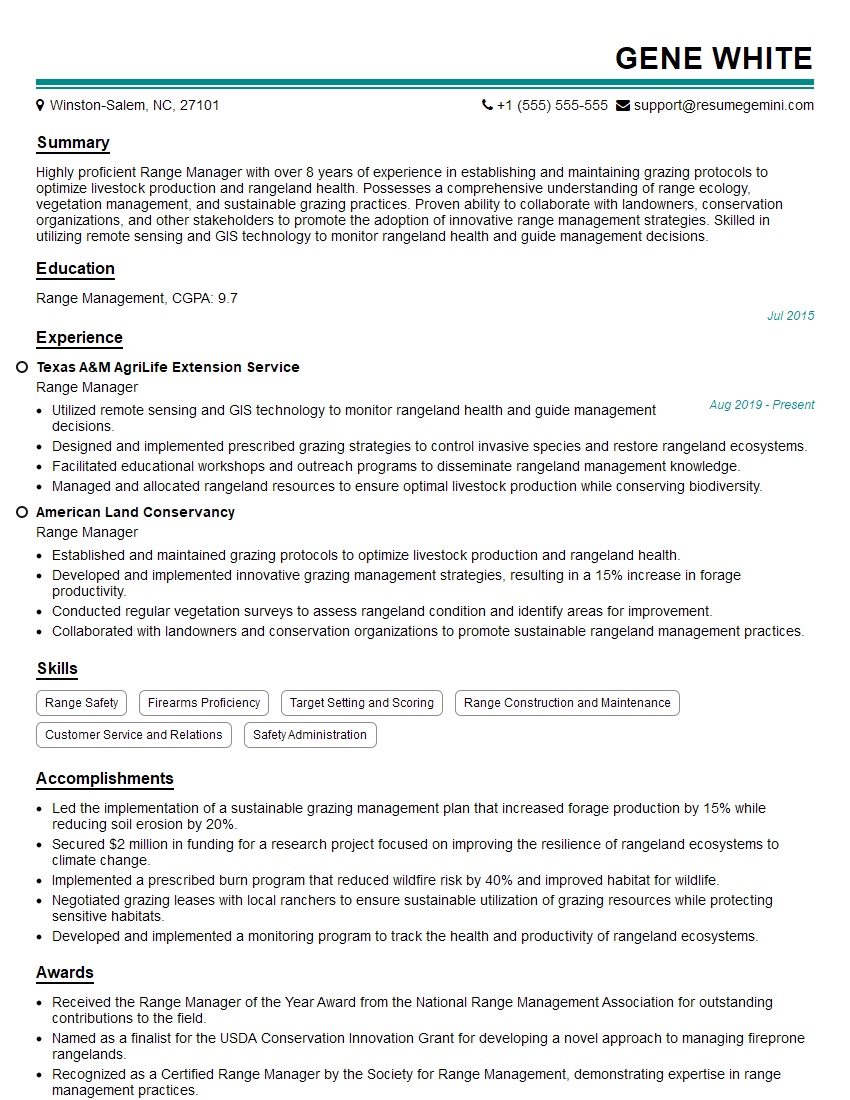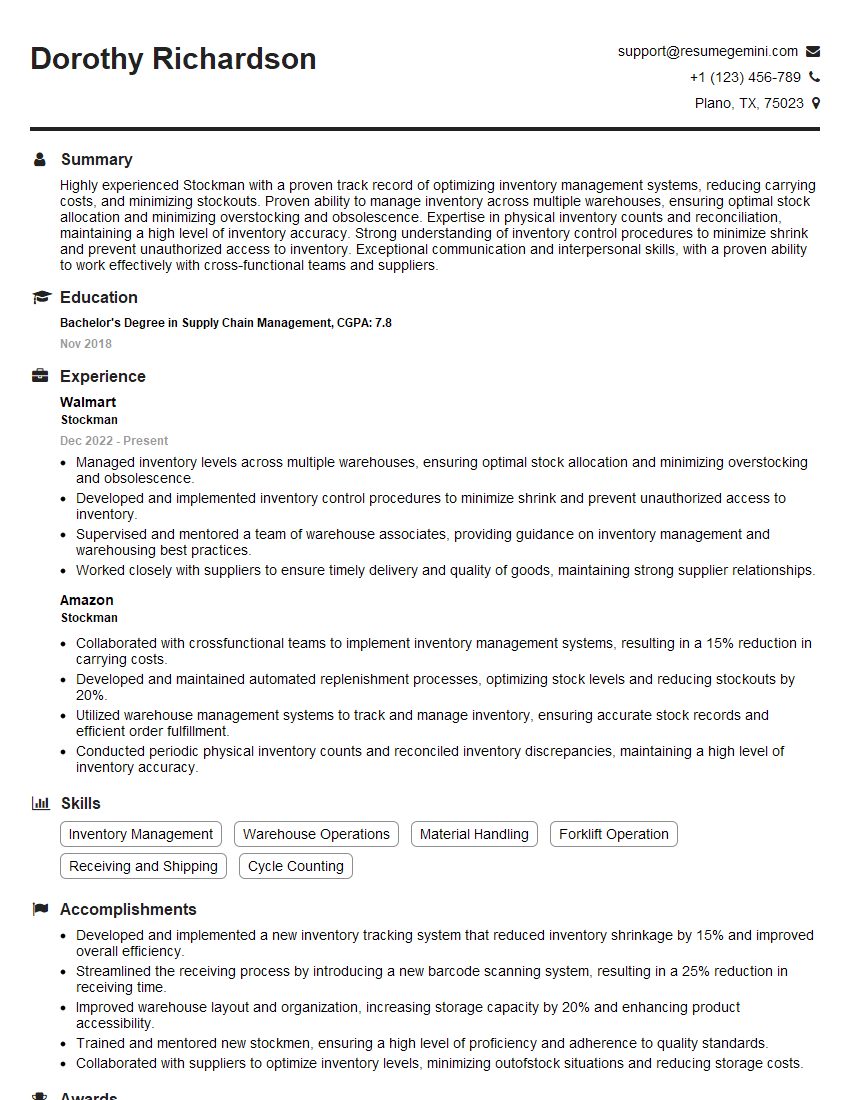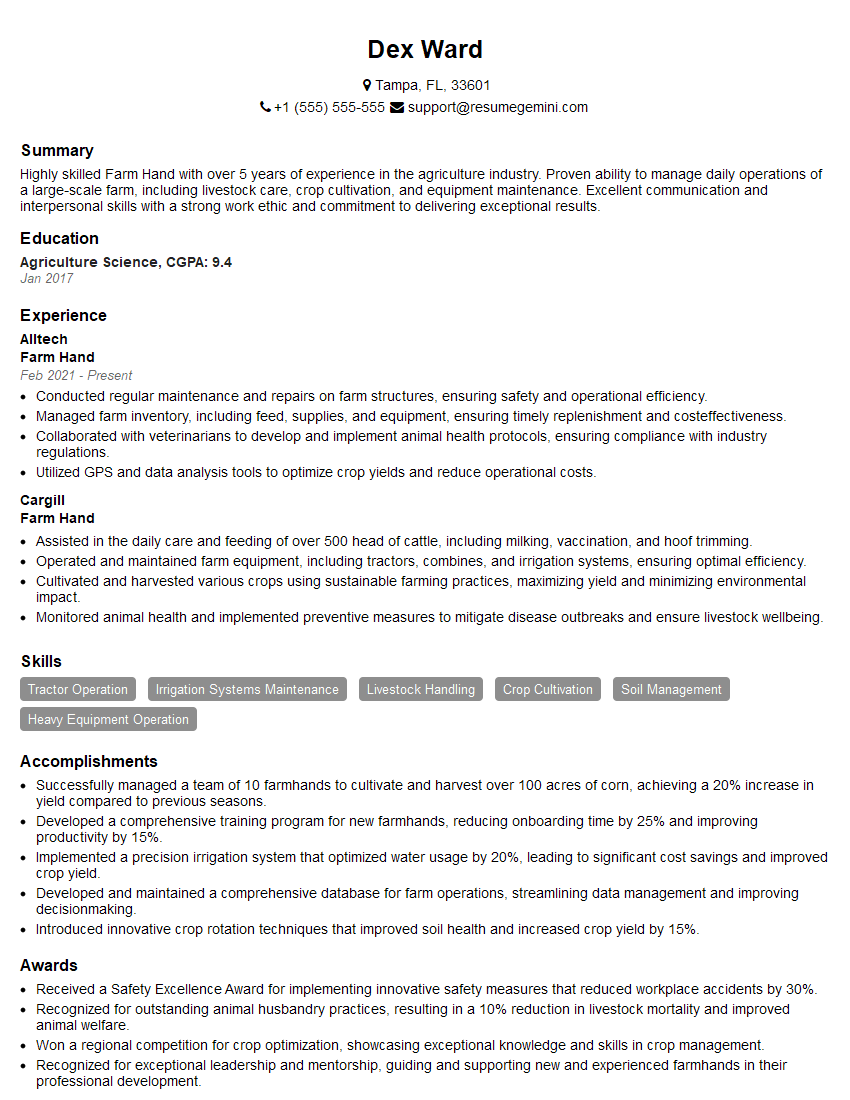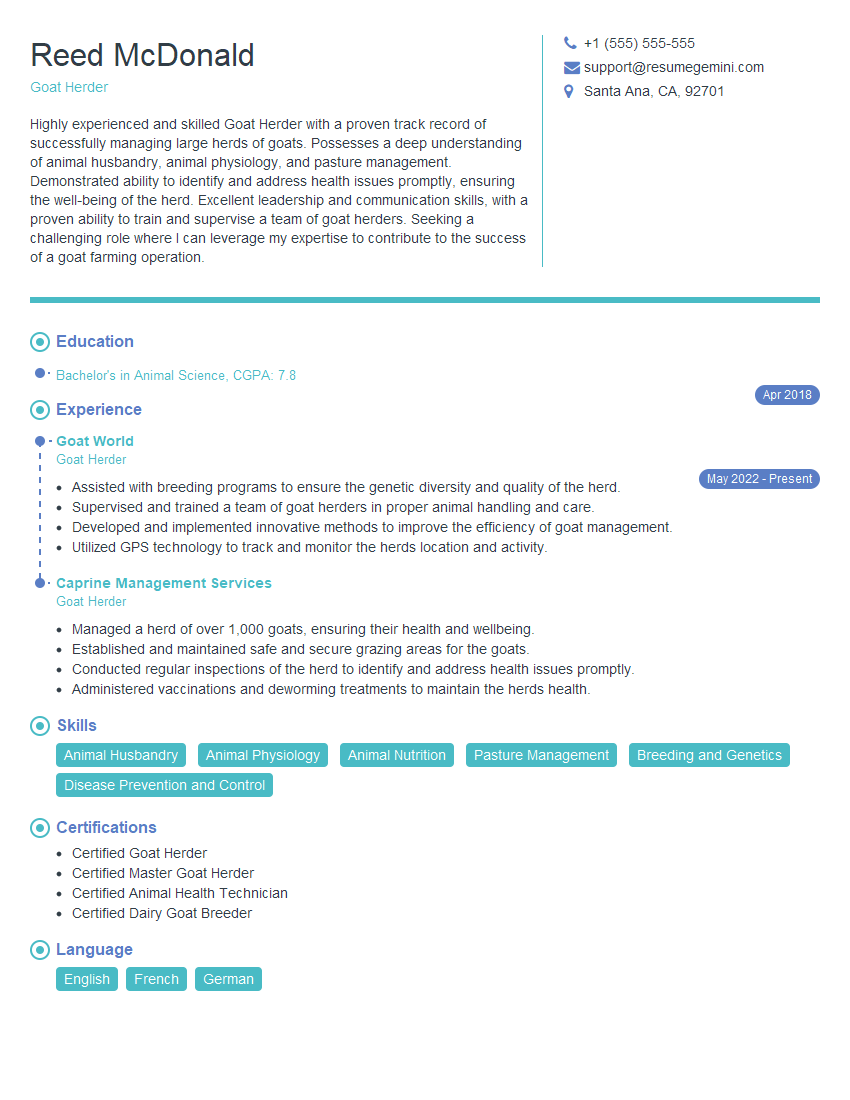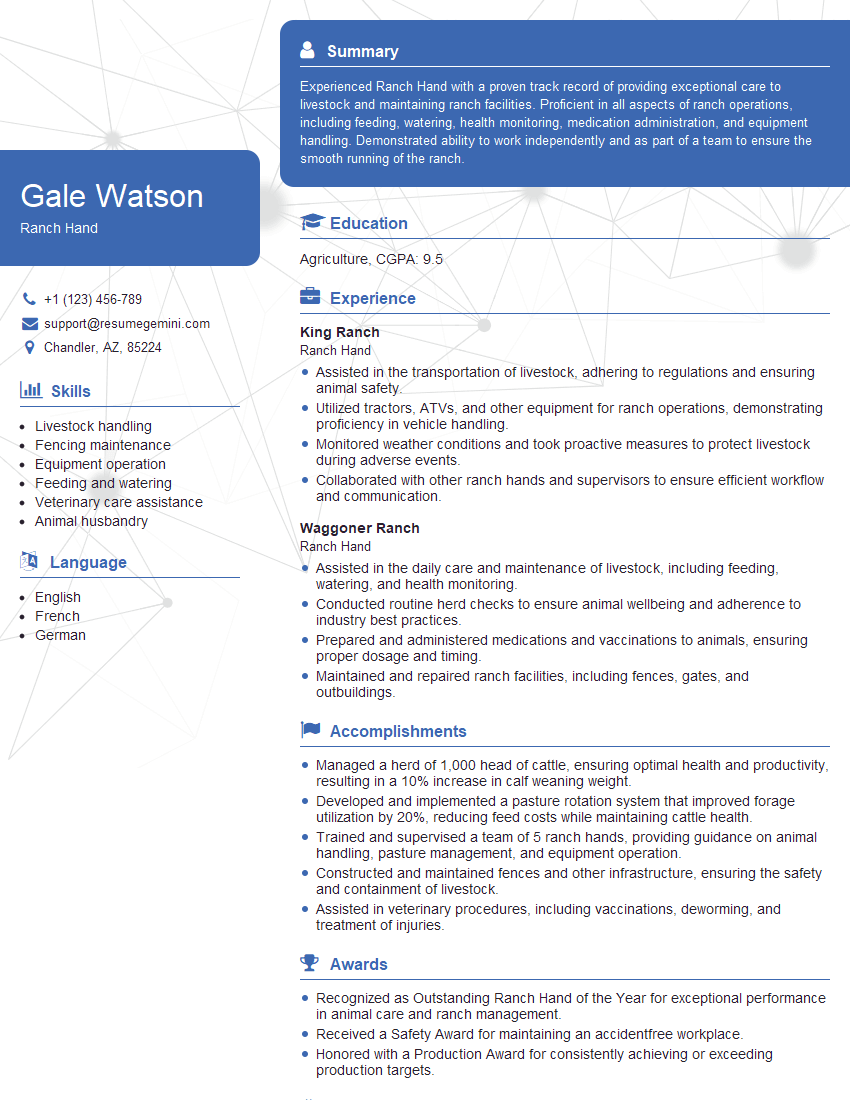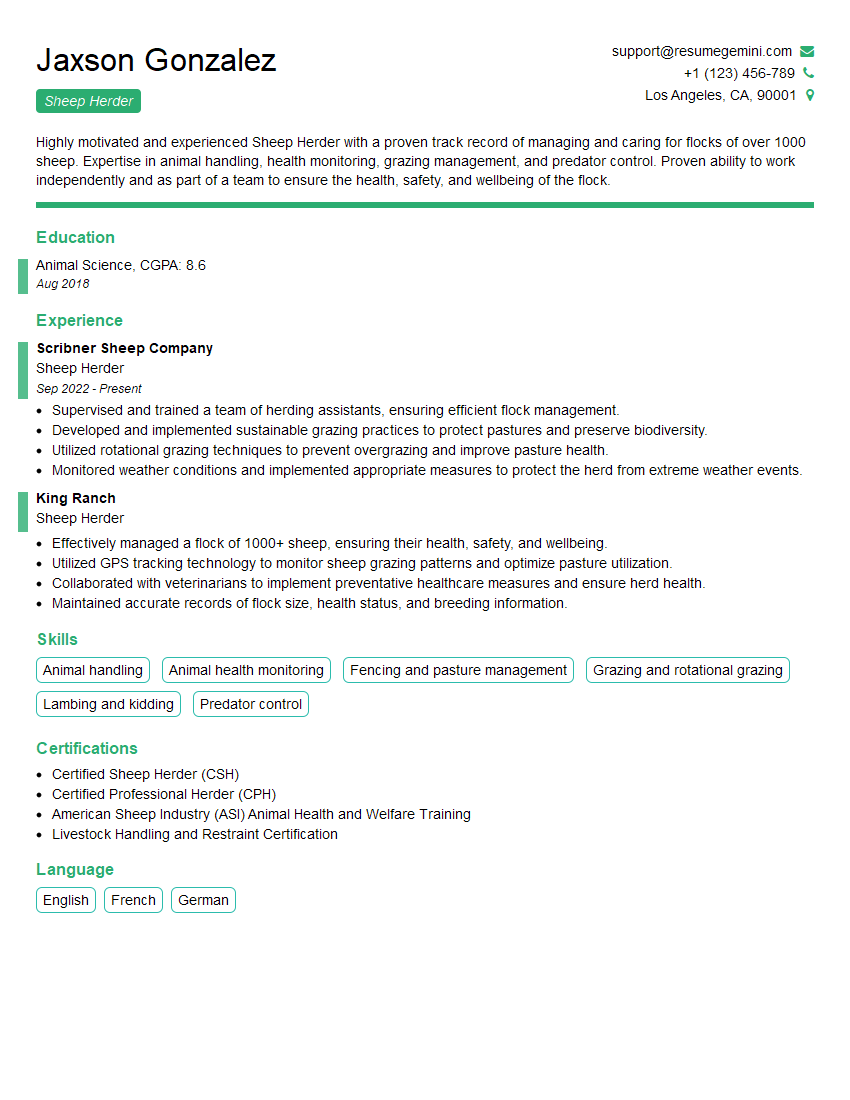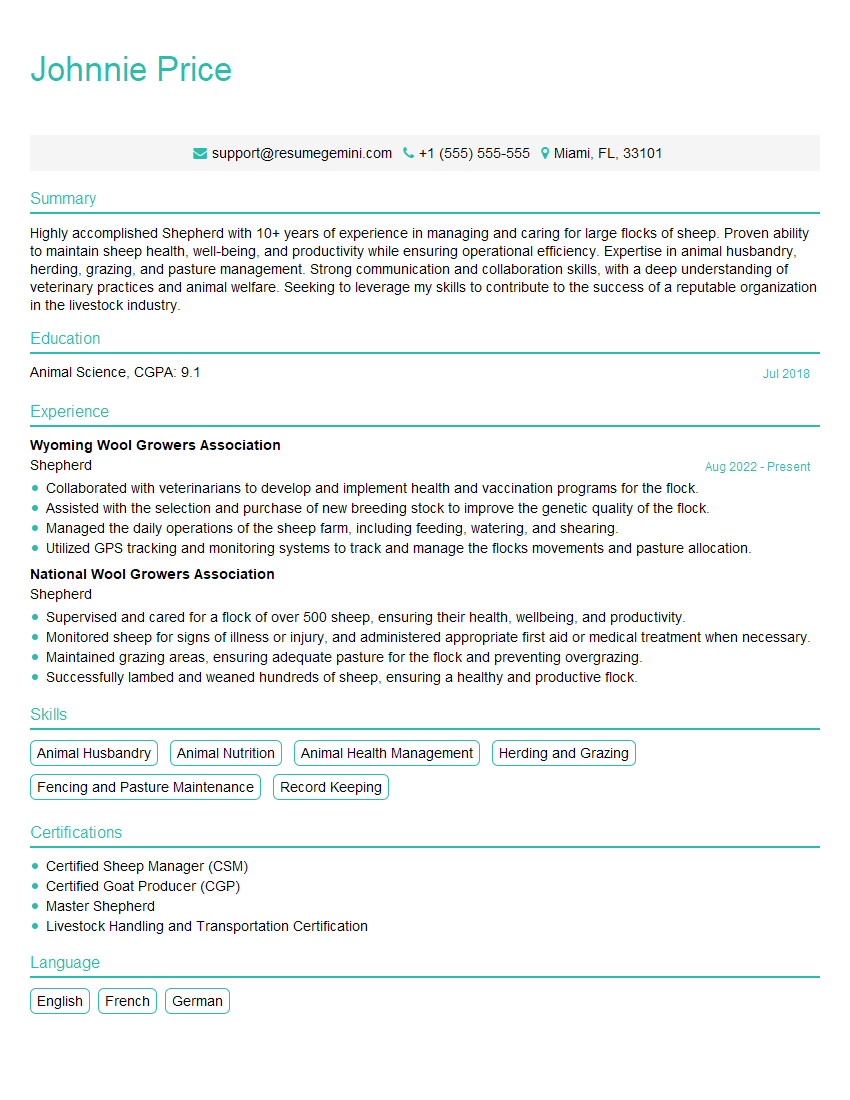Are you ready to stand out in your next interview? Understanding and preparing for Herding and Grazing interview questions is a game-changer. In this blog, we’ve compiled key questions and expert advice to help you showcase your skills with confidence and precision. Let’s get started on your journey to acing the interview.
Questions Asked in Herding and Grazing Interview
Q 1. Describe your experience with different herding techniques.
My experience encompasses a range of herding techniques, adapting my approach to the specific livestock, terrain, and management goals. For example, with sheep, I’ve employed both low-stress stockmanship techniques, focusing on understanding their behavior and using gentle movements and vocalizations to guide them, and more traditional methods like using border collies for herding and control. With cattle, I’ve utilized techniques involving herding dogs, quad bikes for guiding larger herds across challenging terrain, and low-stress handling practices in confined spaces like loading chutes. Each method requires understanding the animal’s psychology; forcing animals rarely yields positive results, causing stress and potentially injury. I always prioritize animal welfare.
In mountainous regions, I’ve used a combination of herding dogs and strategic placement of human handlers to efficiently move animals along designated paths. In flatter areas, I’ve leveraged quad bikes to manage larger herds, focusing on consistent signals and avoiding sudden movements that could spook the animals. My experience also includes working with mixed herds, requiring a nuanced understanding of each species’ behavioral nuances.
Q 2. What are the key factors to consider when planning pasture rotation?
Pasture rotation planning hinges on several crucial factors. Firstly, rest periods are paramount. Grazing animals need sufficient time for pasture regrowth, preventing overgrazing which leads to soil erosion and reduced forage quality. The length of rest depends on factors like pasture type, climate, and livestock density. Secondly, species composition plays a role; different species have varying grazing patterns and nutrient needs. For instance, cattle tend to graze taller plants, while sheep prefer shorter vegetation. Rotating different species ensures all forage resources are utilized. Thirdly, soil health is crucial. Overgrazing damages soil structure and reduces nutrient availability. Rotation helps maintain soil health by minimizing soil compaction and encouraging natural nutrient cycling. Finally, parasite management is often a consideration. Regular pasture rotation disrupts the parasite life cycle, reducing the incidence of internal parasites. Planning should involve creating a grazing schedule and regular pasture monitoring to ensure effectiveness.
For example, I might plan a rotation for a farm with three pastures, allowing one pasture to rest while the other two are grazed, then rotating every two to three weeks, dependent on the pasture’s regrowth capacity.
Q 3. Explain your understanding of rotational grazing systems.
Rotational grazing involves dividing pastures into smaller paddocks and systematically moving livestock between them. This prevents overgrazing and encourages healthy pasture growth. There are various systems, including continuous rotational grazing where livestock are moved frequently, and intensive rotational grazing involving high stocking density and short grazing periods followed by long rest periods. The key is to allow sufficient rest for plant recovery and soil health. This technique has several advantages: improved forage quality, increased carrying capacity (more animals per acre), better soil health, and reduced weed growth. It also minimizes parasite burdens and reduces environmental impacts.
Imagine a farm divided into five paddocks. In intensive rotational grazing, the herd might graze one paddock for only a day or two before moving to the next, allowing the previously grazed paddock several weeks of rest to regenerate. This approach mimics nature’s grazing patterns and fosters a healthy ecosystem.
Q 4. How do you manage livestock health within a grazing system?
Livestock health management within a grazing system is crucial for both animal welfare and economic success. It involves a multi-faceted approach. Regular observation is key; noting changes in animal behavior, appetite, and physical condition is crucial for early detection of illness. Preventative measures include vaccination programs tailored to the specific region and livestock type, regular parasite control, and provision of clean water and adequate shelter. Nutritional management is vital, ensuring animals receive the right balance of nutrients through grazing and, where necessary, supplementary feeding. Record keeping is essential for tracking animal health, vaccinations, treatments, and breeding cycles. Prompt veterinary attention when needed is paramount. In my experience, proactive management is far more effective than reactive intervention, reducing financial losses and animal suffering. For example, regular fecal egg counts to monitor parasite loads allow for timely deworming, preventing debilitating infestations.
Q 5. What are the common challenges faced in herding livestock?
Herding livestock presents several challenges. Difficult terrain, such as steep hills or dense vegetation, can make moving animals difficult and time-consuming. Weather conditions can also pose significant challenges, with extreme heat, cold, rain, or snow impacting animal behavior and herding efficiency. Predator presence necessitates careful management and protective measures. Animal behavior itself can be challenging; some animals are more docile than others, and unexpected movements within the herd can disrupt the process. Disease outbreaks and parasite infestations require immediate attention and effective management strategies. Dealing with stray animals is also a common challenge, requiring tracking and retrieval measures.
Q 6. How do you address aggressive or problematic animals within a herd?
Addressing aggressive or problematic animals requires a calm and methodical approach. Firstly, understanding the root cause of the aggression is essential. Is it due to pain, fear, dominance behavior, or learned behavior? Secondly, separation from the rest of the herd may be necessary to prevent escalation or injury to other animals. Gentle handling techniques and low-stress stockmanship principles are vital, avoiding any actions that might trigger further aggression. In some cases, professional veterinary intervention might be needed to assess underlying medical conditions. Training techniques, like positive reinforcement, can help modify problematic behavior. In extreme cases, where an animal poses a persistent danger, humane euthanasia might be considered as a last resort, always prioritizing animal welfare.
For example, an aggressive bull might be temporarily separated from the herd and worked with individually, using slow movements and avoiding direct eye contact to reduce stress. A veterinary check would rule out pain as the cause of its aggressive behavior before implementing behavioral modification strategies.
Q 7. Describe your experience with different types of livestock.
My experience encompasses various livestock species, including cattle (beef and dairy), sheep, goats, and pigs. Each species presents unique challenges and requires a tailored approach. Cattle, for instance, are generally easier to manage in large groups, but require careful handling during procedures like vaccination or weighing. Sheep are more prone to flocking behavior, requiring close attention to avoid separation and stress. Goats are agile and can be challenging to contain in rough terrain. Pigs require a different approach altogether, emphasizing cleanliness, appropriate housing, and careful consideration of their social structure. Understanding the specific needs and behavior of each species is crucial for effective management and animal welfare.
Working with dairy cattle requires knowledge of milking routines and associated management practices, while managing beef cattle focuses on grazing strategies and fattening programs. Similarly, managing sheep flocks requires understanding breeding cycles and lambing practices.
Q 8. What are the signs of animal stress or illness?
Recognizing stress and illness in livestock is crucial for their well-being and productivity. Early detection can prevent significant losses. Signs can be subtle or obvious, varying depending on the species and the severity of the issue.
- Behavioral changes: Lethargy, isolation from the herd, changes in appetite (either increased or decreased), difficulty standing or walking, excessive vocalization, or aggression can all indicate a problem. For example, a cow consistently lagging behind the herd during grazing could be showing early signs of lameness or illness.
- Physical signs: These include changes in body condition (weight loss or gain), fever, nasal discharge, coughing, diarrhea, changes in respiration rate, lameness, or visible wounds. A sheep with matted fleece near its rear end might indicate diarrhea and potentially illness.
- Monitoring vital signs: Regularly checking temperature, heart rate, and respiration rate can help identify deviations from the normal range for the species. This requires familiarity with normal ranges for different age groups and breeds.
It’s important to remember that these are general indicators. A thorough veterinary examination is necessary for accurate diagnosis and treatment.
Q 9. How do you monitor the nutritional needs of your livestock?
Monitoring nutritional needs requires a multi-faceted approach that combines observation, record-keeping, and potentially lab analysis. The goal is to ensure animals receive sufficient nutrients for optimal growth, reproduction, and overall health.
- Visual assessment of animals: Regularly assess body condition score (BCS) – a visual scoring system used to evaluate fat reserves. A low BCS indicates undernutrition. Also monitor for signs of deficiencies such as pale mucous membranes (anemia), rough hair coat, or poor hoof quality.
- Forage analysis: Regularly sample and analyze the pasture to determine nutrient content (protein, energy, minerals, vitamins). This helps ensure the forage meets the animal’s requirements. A soil test is often a necessary precursor to determine if deficiencies exist in the soil and if supplemental fertilizer is needed.
- Record-keeping: Maintain detailed records of feed intake, animal weight gains or losses, and reproductive performance. This allows for identifying trends and adjusting the feeding program as needed. For example, if weight gain is slower than expected, we may need to increase the level of supplementation or change the forage type.
- Supplemental feeding: If forage analysis reveals deficiencies or animals are not meeting their nutritional needs, supplemental feeding with mineral supplements, protein sources, or energy concentrates is often necessary.
The specific nutritional needs will vary depending on the animal species, breed, age, production stage (e.g., pregnancy, lactation), and environmental conditions. The success of the monitoring strategy depends on a holistic approach.
Q 10. What are the benefits of using herding dogs?
Herding dogs offer numerous benefits in livestock management, enhancing efficiency and animal welfare. They are especially valuable in situations where large land areas or challenging terrain are involved.
- Improved grazing management: Dogs can efficiently move animals between pastures, preventing overgrazing in one area and promoting more uniform grazing distribution, thereby promoting healthier pastures.
- Reduced labor costs: They reduce the need for manual labor in moving animals, saving time and effort. This is particularly useful during mustering, herding for health checks, or moving livestock to different locations.
- Enhanced animal welfare: Well-trained herding dogs can move livestock calmly and efficiently, reducing stress on the animals compared to other methods. This is especially important for sensitive animals such as sheep.
- Increased safety for handlers: Dogs can perform dangerous tasks, like separating aggressive animals or moving livestock in confined areas, reducing risks for human handlers.
- Improved predator control: Certain breeds are effective in deterring predators and protecting livestock, especially in areas where predators are prevalent.
The key to success with herding dogs lies in proper training and understanding of canine behavior. A well-trained dog is an invaluable asset to any livestock operation.
Q 11. Explain your experience with pasture fencing and maintenance.
Pasture fencing is the backbone of effective grazing management. Properly constructed and maintained fences are essential for controlling livestock movement, preventing escapes, and protecting pastures from damage.
- Fence type selection: The choice of fencing depends on factors such as terrain, animal type, and budget. Options include woven wire, electric fencing, and high-tensile wire. Woven wire is strong and durable, electric fencing is effective for containing most livestock, and high-tensile wire provides a strong and inexpensive option.
- Construction: Proper fence construction is critical. Posts should be firmly set, wire tension should be optimal, and gates must be securely latched to prevent escapes. I always ensure to have sturdy corner posts and use correct tensioning methods to prevent sagging.
- Maintenance: Regular inspection and maintenance are essential. This includes repairing broken wires, replacing damaged posts, and keeping vegetation clear from the fence line. Ignoring maintenance leads to costly repairs and potential livestock escapes. For instance, I routinely check my fences for damage after storms or periods of heavy snowfall.
- Gate management: Gates should be securely latched and regularly inspected for functionality. Broken gates can compromise the entire fencing system, allowing animals to escape and potentially damage neighboring properties.
A well-maintained fence system is a significant investment that protects livestock and improves grazing efficiency.
Q 12. Describe your understanding of forage quality and its impact on livestock.
Forage quality is a crucial factor influencing livestock productivity and health. It encompasses several factors that determine the nutritional value of the plant material consumed by animals.
- Nutrient content: High-quality forage is rich in digestible protein, energy, vitamins, and minerals. This influences factors such as milk production in dairy animals, growth rate in young animals, and overall animal health.
- Digestibility: Easily digestible forage is better utilized by the animal. Factors such as plant maturity and the presence of lignin (a complex polymer) affect digestibility. Younger plants generally have higher digestibility.
- Palatability: Animals prefer certain forages over others. Palatability influences intake and consequently, nutrient intake. For instance, a pasture containing weeds that livestock find unpalatable will reduce overall intake and have negative nutritional impacts.
- Toxicity: Some plants are toxic to livestock. Identifying and managing poisonous plants is essential to prevent animal poisoning.
Poor forage quality can lead to reduced growth rates, lower milk production, reproductive problems, and increased susceptibility to diseases. Regular monitoring of forage quality through analysis and observation is crucial for maximizing animal performance and profitability. This knowledge allows me to make informed decisions about supplementation and grazing management.
Q 13. How do you assess the carrying capacity of a pasture?
Assessing pasture carrying capacity is crucial for sustainable grazing management. Carrying capacity refers to the maximum number of animals a pasture can support without causing damage to the vegetation or degrading the land.
- Forage production: Estimate the total amount of forage produced per unit area (e.g., pounds per acre) annually. This requires knowledge of the pasture’s species composition and productivity. This assessment often involves forage yield testing and species identification.
- Animal requirements: Determine the average daily forage consumption per animal. This varies depending on animal species, size, age, and production level.
- Grazing period: Consider the length of the grazing season. The carrying capacity is adjusted based on the period during which the pasture is grazed.
- Utilization rate: Estimate the percentage of forage that can be grazed without causing detrimental impact on plant regrowth. Typically, a utilization rate of 40-60% is considered sustainable.
Carrying Capacity = (Total Forage Production * Utilization Rate) / (Average Daily Forage Consumption per Animal)
By carefully calculating these factors, I can determine the optimal stocking rate (number of animals per unit area) to ensure sustainable grazing and avoid overgrazing. Regular monitoring is essential to adjust stocking rates as conditions change (e.g., drought, high rainfall).
Q 14. What are the environmental considerations in grazing management?
Environmental considerations are paramount in sustainable grazing management. Poor grazing practices can have significant negative impacts on the environment.
- Soil erosion: Overgrazing can lead to soil compaction and erosion, degrading soil fertility and increasing runoff. This is especially a concern on sloped land. Implementing strategies like rotational grazing helps minimize this.
- Water quality: Poor grazing management can contaminate water sources with animal waste, impacting water quality and potentially harming aquatic life. I ensure proper fencing around water sources to prevent contamination.
- Greenhouse gas emissions: Livestock contribute to greenhouse gas emissions (methane). Improved grazing management practices such as rotational grazing can help mitigate these impacts by promoting healthier pastures.
- Biodiversity: Monoculture pastures can negatively impact biodiversity. Promoting diverse plant species through strategic grazing and pasture management encourages biodiversity.
- Weed control: Overgrazing can promote weed growth, further impacting biodiversity and pasture quality. Proper stocking rates and grazing management are critical for weed control.
Implementing sustainable grazing practices that balance livestock production with environmental protection is crucial. Techniques like rotational grazing, managing grazing intensity, and monitoring soil health are integral components of environmentally responsible grazing management. It’s not just about producing livestock efficiently, but doing so responsibly.
Q 15. How do you handle predators or other wildlife threats?
Predator and wildlife management is crucial for successful herding and grazing. My approach is multi-faceted, prioritizing prevention and employing various control methods as needed. Prevention involves selecting grazing lands strategically, considering natural barriers like rivers or rocky outcrops that can deter predators. Proper fencing, especially using predator-resistant materials, is paramount. We also utilize guardian animals, such as llamas or donkeys, which are highly effective at protecting livestock from coyotes, wolves, and other predators. They act as vigilant watchdogs, warning the herd and aggressively confronting threats. In cases where predators become persistent despite preventative measures, we may resort to more assertive methods, always complying with local regulations and consulting with wildlife professionals. This could include employing trained hunting dogs, using non-lethal deterrents like noisemakers or flashing lights, or in extreme circumstances, lethal control under strict permits.
For example, on one ranch, we successfully integrated llamas into a sheep herd. The llamas’ presence significantly reduced coyote predation, leading to a noticeable increase in lamb survival rates. This demonstrated the cost-effectiveness and humane aspect of using guardian animals. The key is a holistic strategy, focusing first on prevention and employing other methods only when necessary.
Career Expert Tips:
- Ace those interviews! Prepare effectively by reviewing the Top 50 Most Common Interview Questions on ResumeGemini.
- Navigate your job search with confidence! Explore a wide range of Career Tips on ResumeGemini. Learn about common challenges and recommendations to overcome them.
- Craft the perfect resume! Master the Art of Resume Writing with ResumeGemini’s guide. Showcase your unique qualifications and achievements effectively.
- Don’t miss out on holiday savings! Build your dream resume with ResumeGemini’s ATS optimized templates.
Q 16. Explain your experience with water management in grazing systems.
Water management is paramount in successful grazing operations. Insufficient water access leads to stress, reduced productivity, and poor animal health. My experience encompasses various techniques, from designing and maintaining traditional watering troughs to utilizing more sophisticated systems. This includes planning for water sources’ location and accessibility, ensuring they are adequately sized for the herd, and regularly checking water quality. In arid regions, efficient water harvesting techniques become vital. We employ rainwater harvesting systems, strategically placing tanks and using water-efficient troughs to minimize loss through evaporation. Understanding the water table and potential for groundwater sources is critical. In some cases, drilling boreholes provides a sustainable water source, especially during prolonged droughts. Regular maintenance of water infrastructure—cleaning troughs, repairing leaks, and implementing rotational grazing practices to avoid overgrazing near water sources—is crucial for maintaining water quality and availability.
For instance, on one ranch with limited water resources, we implemented a system combining rainwater harvesting with strategically located troughs, improving water distribution across the grazing area. This significantly reduced the livestock’s travel time to water, improving their overall health and reducing stress levels.
Q 17. How do you implement a sustainable grazing plan?
Sustainable grazing plans hinge on mimicking natural grazing patterns. The core principle is rotational grazing, dividing the pasture into smaller paddocks and moving the livestock between them. This allows for controlled grazing, preventing overgrazing in any one area, and allowing for pasture recovery and plant diversity. Careful monitoring of pasture health and plant species composition is key. We use a combination of techniques, including visual assessments, species composition surveys, and soil testing, to assess grazing impact. Soil health indicators such as organic matter content, water infiltration rates, and microbial activity are important metrics. The grazing plan should adapt based on these assessments, adjusting stocking rates, grazing periods, and paddock sizes as needed to maintain ecological balance. It’s crucial to incorporate rest periods into the grazing cycle, allowing vegetation to recover fully. This fosters biodiversity, enhances soil health, and improves overall pasture productivity.
For example, we implemented a three-paddock rotational grazing system on a farm experiencing soil degradation. By carefully monitoring pasture recovery and adjusting stocking rates based on plant health indicators, we observed a significant improvement in soil health, leading to healthier pastures and increased livestock productivity. A key element here is careful planning and flexibility to adapt the plan based on actual conditions.
Q 18. Describe your experience with livestock record-keeping.
Comprehensive livestock record-keeping is fundamental for efficient and profitable grazing operations. My experience involves maintaining detailed records on individual animals, encompassing identification (ear tags, branding), birth dates, breeding information, weight gain data, vaccinations and treatments, and health records. This data is essential for informed decision-making. We utilize both physical record books and digital databases, often integrating software tailored for livestock management. These systems provide detailed reporting capabilities, facilitating analysis of productivity, health trends, and overall herd performance. Such records are essential for complying with regulatory requirements, optimizing breeding strategies, tracking feed efficiency, and identifying potential health issues early on. They also play a vital role in managing herd finances, enabling accurate calculation of costs, revenues, and overall profitability.
For example, by tracking individual animal weights and feed intake, we were able to identify a group of animals with lower-than-average weight gain. This enabled us to investigate potential health issues and adjust their diets, improving their performance and overall herd profitability.
Q 19. How do you handle injuries or emergencies with livestock?
Handling livestock injuries and emergencies requires preparedness, prompt action, and a calm approach. We maintain a well-stocked first-aid kit specifically for livestock, containing necessary supplies for wound cleaning, bandaging, and administering medications. Knowing how to handle common injuries, such as cuts, lameness, and dystocia (difficult birth), is crucial. We regularly conduct training to ensure our team has the necessary skills. In serious emergencies, immediate veterinary attention is sought. Knowing the location of the nearest veterinary services and having established relationships with veterinary professionals are vital. Effective communication with the veterinary team and promptly providing relevant information, like the animal’s history and current symptoms, allows for rapid diagnosis and treatment. Prevention is a key component, as well, including regular hoof trimming, vaccination protocols, and proper pasture management to reduce the likelihood of injuries.
For instance, we once had a cow with a severe leg injury. Quick action, prompt veterinary care, and careful follow-up led to a successful recovery. Having established a good working relationship with the vet ensured efficient communication and access to timely expertise.
Q 20. What are the different types of grazing systems?
Several grazing systems exist, each with its own advantages and disadvantages, tailored to different climates, land types, and livestock. These include:
- Continuous Grazing: Livestock graze freely across a pasture throughout the year. Simple to manage but can lead to overgrazing and reduced pasture quality.
- Rotational Grazing: Livestock graze in different paddocks for a set period, then move to another, allowing for pasture recovery. This promotes better pasture health and improved forage quality.
- Strip Grazing: Similar to rotational, but livestock graze narrow strips of pasture daily, moving forward as they consume the forage. Highly intensive but can achieve high stocking rates.
- Cell Grazing: Very intensive, utilizing very small paddocks for extremely short grazing periods, mimicking natural grazing patterns of wild herds. Promotes high forage utilization and soil health.
- Silvopastoral Systems: Integrating trees into pastures provides shade, windbreaks, and improved biodiversity. Benefits include improved soil health, carbon sequestration, and enhanced livestock welfare.
The choice of system depends on various factors, including the available land, climate, livestock type, and management goals. Often, a combination of systems may be used to optimize pasture management.
Q 21. Explain your understanding of soil health and its relation to grazing.
Soil health is intrinsically linked to grazing management. Healthy soil supports healthy plants, which in turn support healthy livestock. Key indicators of soil health include organic matter content, water infiltration rate, nutrient availability, and microbial activity. Overgrazing depletes soil organic matter, reduces water infiltration, and can lead to soil erosion and compaction. Sustainable grazing practices aim to maintain or enhance soil health. This involves minimizing soil disturbance, promoting plant diversity, and optimizing grazing intensity to ensure adequate recovery time for plants. Techniques like rotational grazing, incorporating cover crops, and minimizing tillage all contribute to improved soil health. Regular soil testing helps to monitor nutrient levels and adjust fertilization practices as needed. Healthy soil leads to improved pasture productivity, higher-quality forage, and enhanced livestock performance.
For example, we observed a significant improvement in soil organic matter content and water infiltration rates on a ranch that transitioned from continuous to rotational grazing. This led to improved pasture productivity, better livestock performance, and a more resilient grazing system.
Q 22. How do you adapt grazing practices to different climates and seasons?
Adapting grazing practices to different climates and seasons is crucial for optimizing livestock health and productivity. It involves understanding the impact of temperature, rainfall, and available forage on animal needs and then adjusting management strategies accordingly.
- Water Availability: In arid climates, water sources become paramount. We strategically locate water troughs, possibly utilizing rainwater harvesting techniques, and adjust grazing rotations to minimize travel distances for the animals. During drought, supplementary feeding becomes crucial, supplementing the scarce natural forage.
- Forage Management: In wet seasons, we might use rotational grazing to prevent overgrazing and soil erosion. This involves dividing pastures into smaller paddocks and rotating livestock between them, allowing time for forage regeneration. In dry seasons, we carefully monitor forage quantity and quality, potentially supplementing with hay or other feedstuffs to maintain animal condition. We might also employ strategies like deferred grazing, where high-quality pastures are left ungrazed until later in the season.
- Temperature Regulation: Extreme temperatures, whether hot or cold, impact animal comfort and performance. In hot climates, we ensure access to shade, possibly through planting trees or providing shade structures. In cold climates, we provide windbreaks and may need to adjust the feeding schedule to provide additional energy.
- Pest and Disease Control: Climate influences the prevalence of parasites and diseases. We monitor for these and adapt our treatment strategies as needed. For instance, a wet season might lead to a higher risk of internal parasites.
For example, on my ranch, we use a combination of rotational grazing and strategic supplementary feeding to manage our cattle herd throughout the year. During the hot summer months, we move the cattle to higher-elevation pastures with better access to water and shade. In winter, we provide hay and adjust grazing rotations to focus on areas with sufficient forage cover.
Q 23. Describe your experience with livestock transportation and handling.
My experience in livestock transportation and handling prioritizes animal welfare and safety. It involves a thorough understanding of best practices to minimize stress and injury during transport and handling procedures.
- Pre-transport Preparation: Animals should be properly rested and watered before transportation. We carefully assess their health, and any sick animals are separated.
- Transportation Methods: The choice of transport depends on the distance and animal type. For shorter distances, we might utilize trailers, ensuring appropriate ventilation and space. Longer distances require specialized transport with regular stops for water and rest. We adhere strictly to all relevant animal welfare regulations during transportation.
- Handling Techniques: We employ low-stress handling techniques that minimize the use of force. This involves calm and quiet behavior, proper use of chutes and alleys, and avoidance of sudden movements or loud noises. Electric prods are used only as a last resort, prioritizing the gentle guidance of animals.
- Post-transport Care: Upon arrival, animals need time to recover from the stress of travel. We provide access to water, feed, and rest, and monitor their behavior for any signs of injury or illness.
In one instance, we transported a large herd of sheep across state lines. Careful planning, including regular stops for rest and water, resulted in minimal stress to the animals and a smooth arrival at the destination. No injuries or mortality were reported, showcasing the success of well-managed transportation.
Q 24. What are the key performance indicators (KPIs) you monitor in your herding/grazing operations?
Monitoring Key Performance Indicators (KPIs) is essential for efficient and profitable herding and grazing operations. We track several metrics to assess the health and productivity of our livestock and the overall effectiveness of our management strategies.
- Weight Gain: We regularly weigh animals to monitor their growth rate, helping us assess the effectiveness of our feeding and grazing management practices. A decline in weight gain can signal a problem requiring investigation.
- Reproduction Rates: For breeding animals, we track conception rates and birth rates. These KPIs help us assess the reproductive health of the herd and identify potential issues, like infertility or nutritional deficiencies.
- Mortality Rates: Tracking mortality helps pinpoint potential disease outbreaks, management failures, or environmental stressors affecting the animals. A higher-than-average mortality rate warrants immediate investigation.
- Forage Production: We assess forage quality and quantity through regular pasture assessments, ensuring there’s adequate feed available to support the livestock. This might involve measuring biomass, evaluating nutritional content, and assessing pasture health.
- Financial KPIs: Finally, we monitor financial indicators like operational costs, feed costs, and overall profitability. These are crucial for the long-term sustainability and economic viability of the operation.
For example, a sudden drop in weight gain might indicate a parasite infestation, prompting us to implement a deworming program. Similarly, low reproduction rates could suggest nutritional deficiencies, necessitating changes to the feeding regime.
Q 25. How do you deal with conflicting priorities in livestock management?
Conflicting priorities are common in livestock management. Balancing animal welfare, financial sustainability, environmental considerations, and regulatory compliance requires careful planning and prioritization.
- Prioritization Matrix: We use a prioritization matrix to rank competing goals based on their importance and urgency. This helps us focus resources on the most critical aspects first.
- Compromise and Negotiation: Sometimes, compromises are necessary. For example, improving pasture quality might require temporarily reducing stocking density, impacting short-term profits but enhancing long-term sustainability. We negotiate solutions that meet the needs of stakeholders.
- Data-Driven Decision Making: We rely on data to inform our decisions. Monitoring KPIs helps us assess the impact of different management strategies, allowing us to make evidence-based choices. For example, comparing the costs and benefits of different feeding strategies can help us balance animal health with economic viability.
- Adaptive Management: We accept that our plans might need to change, adapting to unforeseen circumstances like weather events or disease outbreaks. Flexibility and responsiveness are crucial in handling conflicting priorities effectively.
For instance, we might face a conflict between maximizing profits by increasing stocking density and protecting pasture health. Using a prioritization matrix and considering long-term sustainability, we might opt for a slightly lower stocking rate to maintain pasture health, ensuring higher profitability in the long run.
Q 26. What is your experience with budgeting and resource allocation in livestock operations?
Budgeting and resource allocation are fundamental to successful livestock operations. It involves careful planning, monitoring, and adjustment to ensure resources are used efficiently and effectively.
- Budget Development: We develop detailed budgets that encompass all aspects of the operation, including feed costs, labor costs, veterinary expenses, equipment maintenance, and marketing expenses. We forecast income based on projected production and market prices.
- Resource Allocation: We allocate resources based on the priorities identified in our management plan. This includes determining the optimal stocking rate, deciding on feed types and quantities, and allocating funds for infrastructure improvements and equipment purchases. We continuously monitor expenses.
- Financial Monitoring: Regular monitoring is key to identifying potential overspending and adjusting the budget as needed. We use financial software to track income and expenses, enabling us to make informed decisions about resource allocation.
- Financial Forecasting: We use forecasting models to anticipate future expenses and income, assisting in long-term planning. This allows for proactive adjustments in budget allocation and resource management.
For instance, we developed a detailed budget outlining feed costs based on projected forage availability. When a drought reduced forage production, we adjusted the budget to increase hay purchases, ensuring that animal nutrition wasn’t compromised.
Q 27. How do you ensure animal welfare within your herding/grazing practices?
Ensuring animal welfare is a top priority in our herding and grazing practices. It’s not just ethical, but also crucial for animal productivity and the overall success of the operation.
- Five Freedoms: We adhere to the Five Freedoms of animal welfare: freedom from hunger and thirst, freedom from discomfort, freedom from pain, injury, or disease, freedom to express normal behavior, and freedom from fear and distress. These serve as guiding principles in all our management decisions.
- Routine Health Checks: We conduct regular health checks on the animals, noting any signs of illness or injury. We have a comprehensive disease prevention and treatment program, working closely with veterinarians.
- Adequate Housing and Shelter: We provide animals with adequate shelter to protect them from harsh weather conditions, ensuring they have access to shade in summer and protection from wind and cold in winter.
- Appropriate Grazing Management: We implement rotational grazing systems to ensure that animals always have access to sufficient high-quality forage. Overgrazing is avoided to protect pasture health and provide adequate forage for the animals.
- Humane Handling: We use low-stress handling techniques during routine tasks such as weighing, vaccination, and transport, minimizing stress and discomfort for the animals.
For instance, during a heatwave, we adjusted grazing times to avoid the hottest part of the day and provided extra shade structures to protect the animals from heat stress. This ensured their comfort and well-being, contributing to optimal health and productivity.
Q 28. What are your plans for continuing education in herding and grazing?
Continuing education is essential for staying current with best practices in herding and grazing. The industry is constantly evolving, with new technologies and management techniques emerging regularly.
- Workshops and Conferences: I regularly attend workshops and conferences focused on sustainable grazing practices, animal welfare, and innovative technologies in livestock management. These events offer opportunities to learn from experts and network with other professionals.
- Online Courses and Resources: I utilize online resources like university extension programs and industry publications to access the latest research and best practices. Many valuable resources are available online.
- Mentorship and Collaboration: I actively seek mentorship from experienced ranchers and participate in collaborative projects with other producers. Sharing experiences and best practices contributes greatly to our collective knowledge.
- On-Farm Research Trials: I periodically implement on-farm research trials to test new management strategies and technologies in a practical setting. This hands-on approach allows me to evaluate the effectiveness of new methods firsthand.
For example, I’m currently participating in a workshop on precision grazing utilizing GPS technology for improved pasture management. This will help me refine my grazing rotations and optimize forage utilization.
Key Topics to Learn for Herding and Grazing Interview
- Livestock Behavior and Management: Understanding animal psychology, herd dynamics, and individual animal needs is crucial for effective herding and grazing management. Consider the impact of different breeds and their specific requirements.
- Pasture and Range Management: Learn about rotational grazing, sustainable grazing practices, and the impact of different grazing systems on pasture health and livestock productivity. Explore techniques for optimizing forage utilization.
- Fencing and Infrastructure: Knowledge of various fencing types, their maintenance, and their role in controlling livestock movement is essential. Understand the design and implementation of efficient grazing infrastructure.
- Health and Disease Management: Familiarize yourself with common livestock diseases, preventative measures, and the role of proper grazing management in disease prevention. Understanding parasite control is vital.
- Technology in Herding and Grazing: Explore the use of GPS tracking, remote sensing, and other technologies to optimize herd management and grazing strategies. Consider the integration of data analysis for informed decision-making.
- Safety and Risk Management: Understand the safety protocols and risk management strategies involved in herding and grazing, including handling animals safely and managing potential hazards.
- Financial Management and Budgeting: Explore the financial aspects of herding and grazing, including cost analysis, budgeting, and the economic implications of different grazing systems.
Next Steps
Mastering herding and grazing techniques opens doors to rewarding careers in agriculture, conservation, and land management. A strong foundation in these areas showcases your practical skills and commitment to sustainable practices. To maximize your job prospects, creating an ATS-friendly resume is crucial. ResumeGemini is a trusted resource that can help you build a professional and impactful resume. We provide examples of resumes tailored to the Herding and Grazing field to help you showcase your unique skills and experience effectively. Take advantage of these resources to present yourself as the ideal candidate.
Explore more articles
Users Rating of Our Blogs
Share Your Experience
We value your feedback! Please rate our content and share your thoughts (optional).
What Readers Say About Our Blog
Hello,
We found issues with your domain’s email setup that may be sending your messages to spam or blocking them completely. InboxShield Mini shows you how to fix it in minutes — no tech skills required.
Scan your domain now for details: https://inboxshield-mini.com/
— Adam @ InboxShield Mini
Reply STOP to unsubscribe
Hi, are you owner of interviewgemini.com? What if I told you I could help you find extra time in your schedule, reconnect with leads you didn’t even realize you missed, and bring in more “I want to work with you” conversations, without increasing your ad spend or hiring a full-time employee?
All with a flexible, budget-friendly service that could easily pay for itself. Sounds good?
Would it be nice to jump on a quick 10-minute call so I can show you exactly how we make this work?
Best,
Hapei
Marketing Director
Hey, I know you’re the owner of interviewgemini.com. I’ll be quick.
Fundraising for your business is tough and time-consuming. We make it easier by guaranteeing two private investor meetings each month, for six months. No demos, no pitch events – just direct introductions to active investors matched to your startup.
If youR17;re raising, this could help you build real momentum. Want me to send more info?
Hi, I represent an SEO company that specialises in getting you AI citations and higher rankings on Google. I’d like to offer you a 100% free SEO audit for your website. Would you be interested?
Hi, I represent an SEO company that specialises in getting you AI citations and higher rankings on Google. I’d like to offer you a 100% free SEO audit for your website. Would you be interested?
good
